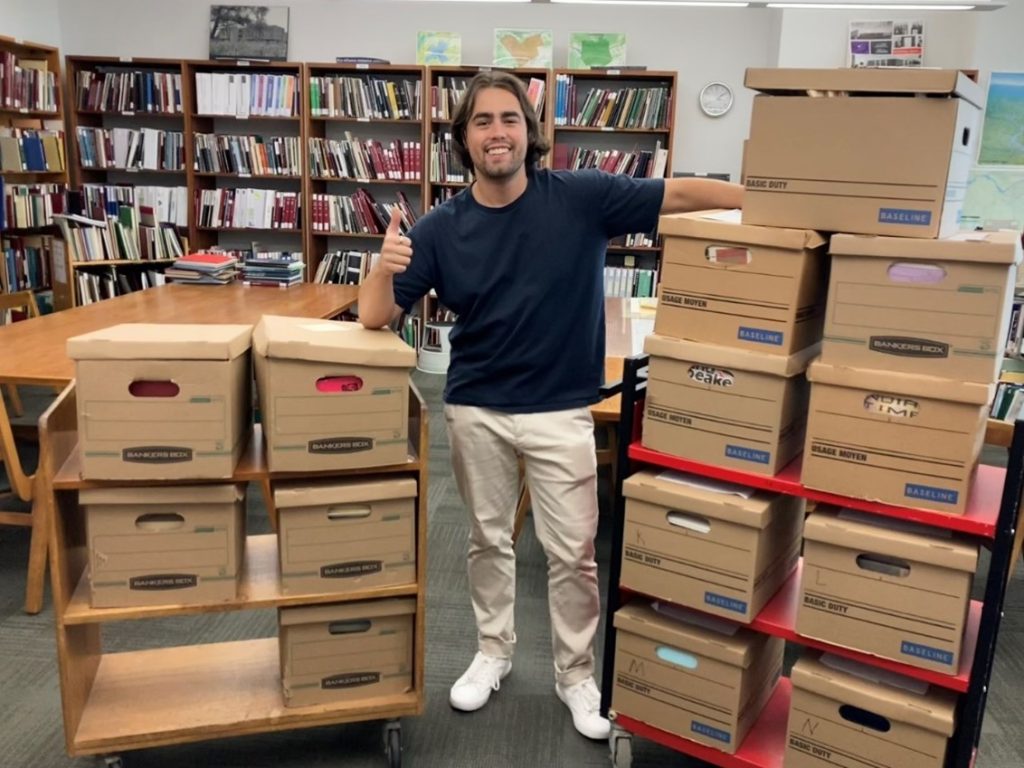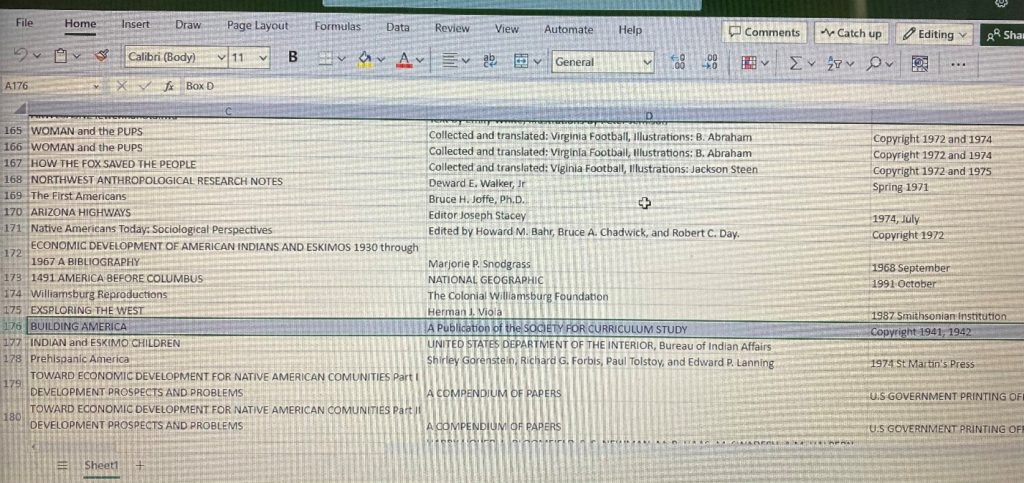by Richard Marchese, Undergraduate Research Assistant
20 October 2023
Originally posted on I-CUREUS Blog, August 2023
I. The Project Briefly:
What is an internship, what is your internship?
An I-CUREUS opportunity is great for anyone looking to expand their horizons as a student at Carleton University. It is a project that gives funding to your coordinator to allow a student to be paid to do some research. For me, the internship has been mostly about archiving books for the Native North American Travelling College. I was looking at the collection of the books left on the shelves of the NNATC over its 50 years of existence, and was then instructed to do an inventory, by entering the data about each book using archival practices to make an archival catalogue of all the books with the appropriate information.

Creating the archive, and the work that went into it:
The work that went into creating the archive could be tedious and repetitive at times, but the information that I learned about the Indigenous population of Canada and America, was so valuable to me that I did not mind. I would take a book from the one of the 14 boxes that were temporarily moved to Carleton’s archives, study its features to evaluate the condition, add the title, ISBN, author, page number, and so on, as I was taught by Chris Trainor, Archivist at Carleton’s Archives and Special Collections. The most interesting part of the job was being able to read some of the information. My personal favourites were the creation stories, the textbooks on a particular tribal group, and the binder’s containing minutes about meetings that the College had. These three things allowed me to get a good insight into the types of things each distinct nation valued and used to survive as the generations of people who lived these amazing lives adapted to their environments.

Why this summer was great:
This summer was great for me. I was able to help an organization that I believe has not only great historical value but future value to the Indigenous population and settler population. I did this by using the research skills I learned at Carleton University. I have always been interested in Indigenous culture and this summer allowed me to explore that with the proper materials and supervision. I-CUREUS, and the NNATC gave me that opportunity and I am very thankful.
II. The Details of the Project:
The most challenging aspect:
The most challenging aspect of the archive project would have to be the amount of time spent reading. Reading titles, information about the book and even in a few cases the books themselves. The repetitiveness of opening a book, finding the information needed and documenting it then repeating the task over and over again was taxing on my focus.
The most rewarding aspect:
Despite the repetitiveness of the project my attention was quickly redirected by the passion that I found for the information in these books. I feel this archive is very important to the future of the Native North American Travelling college. The most rewarding aspect of the project was being able to help an organization that bases itself around education. Especially when that education is going towards a community that has struggled with systematic oppression.
The most interesting aspect:
The most interesting aspect of the project was the trip to the Akwesasne reserve, where I met the organizers and employees of the NNATC, as well as learned more about its history from a firsthand account. I have never been to the reserve for business and education, so it was cool. During our trip to the reserve the NNATC welcomed both myself and my supervisor with open arms and gave us a full tour of the museum and showed us how they do business. It was very exciting and taught me a lot. It was my favourite workday, the NNATC made it feel like a school field trip.

III. The Experience Brought to Life:
Tell us about the collection:
The collection of books that the NNATC provided us with were mostly derived of newspapers, binders containing minutes of past meetings of the NNATC, kids’ books, and other miscellaneous books. Most of the books have one of the NNATC stamps. All the books have a tie to Indigenous life, history, culture, organizations, beliefs, or education. This is because the original purpose of the NNATC was to provide education to people who were sent through the residential schools but wanted to learn more about their culture. The books all come from different collections that were donated to or purchased by the NNATC. These books come from a wide variety of schools, people, and organizations looking to help the cause, and for good reason. What is being done by the NNATC is great.

Oldest – newest books:
The oldest book in the collection was copyrighted in 1941, it is called “Building America”. It is a Publication of the Society for curriculum study, and it is number 176 in the arrival document.
The newest book was a binder containing the curriculum of a course taken by a trustee for the community from 2012.
IV. Working at Carleton:
Tell us about Carleton’s Archives and Special Collections:
The Archives and Special Collections or ASC for abbreviation, is a centre within the Carleton library where this project took place. I would like to thank the people who worked in the office with me Chris, Llyod, and a special congrats to Monica Ferguson who recently retired. Although I worked on this project by myself, we all shared a work environment. They made my experience great and welcomed me in with open arms, truly making me feel like part of a team. The ASC oversees supporting learning at Carleton university and beyond.

Was the I-CUREUS training helpful? If so, what skills did you learn?
The archival training that I received from I-CUREUS was helpful and I learned enough that it was worth my time. When working for I-CUREUS, all research assistants also need to select a training module and I selected self-management, as I felt it was fitting since I was working on my own schedule. I learned things about responsibility, time management and preparation. All these things allowed me to be successful through my I-CUREUS project.
Advice for anyone looking to participate in a project at Carleton or with the Native North American Travelling College:
My advice to anyone looking to participate at a project involving the NNATC or Carleton would be not to think about it, instead, just do it. I learned so much both about myself, the NNATC, Indigenous culture and Indigenous beliefs in general, that I felt there was no better way to spend my summer. Working as an employee at Carleton showed me what a good work environment is supposed to look like. I now have the knowledge and experience to move into successful employment.
ENDNOTES
[1] Ernest Benedict, “Travelling College,” National Film Board, 1968, 9 minutes. https://www-nfb-ca.proxy.library.carleton.ca/film/travelling-college/ . Kelly Monique-Pineault, “Shifting the Balance: Indigenous and Non-Indigenous Activism in The Company of Young Canadians, 1966-1970,” MA Thesis (Canadian and Indigenous Studies), Trent University, 2011, pp. 85-91, mentions book donations from Lakehead University’s Students’ Union and the Ottawa Branch of the Imperial Order of the Daughters of the Empire (IODE). https://www.collectionscanada.gc.ca/obj/thesescanada/vol2/002/MR81117.PDF?oclc_number=881138044 [2] https://www.nnatc.org/ [3] “Ernie and Salli Benedict: Influential father and daughter strengthened Mohawk identity,”March 23rd, 2020, Windspeaker.com, https://windspeaker.com/news/footprints/ernie-and-salli-benedict-influential-father-and-daughter-strengthened-mohawk . [4] Doug George-Kanentiio: A tribute to Ernest Benedict, 1918-2011, Indianz.com, 2011, https://indianz.com/News/2011/000095.aspRichard Marchese is a 5th Year student in Honours Political Science at Carleton University. He completed an undergraduate research assistantship under the joint supervision of Chris Trainor, Archivist, Ann Seymour, Executive Director of the NNATC, and Dominique Marshall, Historian and CNHH founder. The project is part of a larger initiative of the NNATC to celebrate its 50th anniversary in 2024 by highlighting the history and heritage of the college as one of the sources for its renewal.


